Imagine a scenario where you know exactly what your customer wants, even before they do. That’s the power of first-party data.
First-party data is the lifeblood of personalized marketing.
It’s not just about collecting information; it’s about creating a narrative that resonates, a story that connects, and unforgettable experiences.
We will teach you all about what it is, how it works, and how you can leverage it to improve your advertising efforts massively.
What is First-Party Data?
First-party data (also known as 1P data) is information that a company collects directly from its customers. This data can come from customers, subscribers, site visitors, or social media followers.
In practice, this means that you can gather detailed insights about consumer behaviors, preferences, and interests.
It includes data points such as browsing history, purchase history, and customer feedback.
First-party data is the holy grail of customer insights because you own it.
💡Unlike first-party, second-and third-party data are collected and owned by other sources, which means you need to purchase or lease it. This dependency has inherent risks, such as data privacy issues and potential inaccuracies.
Why is First-Party Data Important?
First-party data is uniquely reliable because it’s data you know exactly where it comes from and how it is collected. For this reason, it’s typically more accurate and more accessible than the alternatives.
If you don’t collect first-party data, you’re leaving your marketing efforts open to intentional or unintentional disruption from lack of access to relevant information.
For example, if a third-party data provider goes out of business or has a data breach, your access to critical customer information could be cut off suddenly.
Now let’s focus on second-party data for a little bit.
Second-Party Data
Second-party data refers to the unique scenario where a company gains access to another organization’s first-party data through a mutually beneficial partnership.
This type of data exchange allows businesses to extend their reach beyond their own data capabilities, offering more precise targeting opportunities than what’s possible with their internal resources alone.
For instance, an e-commerce store specializing in athletic wear. The store could partner with a fitness app to share data.
The store might learn from the data that a significant portion of the app’s users are interested in yoga and subsequently launch a targeted campaign for yoga apparel and accessories.
The app’s users get some great deals and the store gets to sell more products. It’s a win-win.
Third-Party Data
Third-party data refers to the information collected by entities that don’t have a direct relationship with the user the data is collected from.
This colossal pool of information is gathered by companies specializing in data collection, who then sell or lease it to other businesses.
For example, a car manufacturer might purchase data from a third-party provider to understand the shopping behavior of potential customers on various online platforms. These insights can help the manufacturer tailor their marketing campaigns more effectively.
Note: Using data from social platforms or search engines is primary example of using third-party data. You’re essentially “borrowing” an insane amount of data which allows you to reach millions of people with accurate targeting.
Despite its benefits, third-party data is often regarded as the least reliable form of data because the sources are not verified, and the accuracy of information cannot be guaranteed.
If you’re using third-party data, it’s a good idea to have a long-term plan to get out of using it and switch to first-party data for the same purposes.
Why First-party Data Is So Powerful
Without a doubt, the most important role of first-party data is to enhance and round out your marketing.
However, it can impact many different aspects of your customer outreach.
First-party data can help you create more effective marketing campaigns. It can help you understand your audience’s needs and preferences, and use specific messaging to reach users engaging with your site.
Personalization with First-party Data
1P data isn’t the only way to personalize your marketing efforts, but it has significant advantages over the alternatives:
- It’s unique to your organization. No other company can access the insights you derive from your user interactions, which means you have a unique understanding of your customer base.
- It’s accurate. Because you have firsthand knowledge of how your data is collected, you can be confident in its quality.
- It’s timely. Rather than waiting on third-party data providers, you have real-time access to your data, allowing you to respond to changes in customer behavior quickly.
Owning The Data You Collect
As already mentioned, the data that you collect is yours to keep. It makes you far less dependent on other sources of data and data providers.
You also get to define the metrics you want to collect and only focus on your business objectives.
In contrast, you’ll often have to pay for data you don’t really need when you purchase it from third-party providers.
Moreover, you have complete control over the data when it’s yours. You’ll quickly discover how much flexibility this gives you in adapting to different strategies.
First-party Data is Accurate and Timely
Data accuracy is crucial in marketing, and first-party data offers an unmatched level of reliability.
Given that this data is collected directly from your customers, there’s a higher chance of it being accurate, as opposed to third-party data, which may contain errors and inaccuracies.
Additionally, since the data is collected in real-time, it’s always up-to-date.
This means that you can adjust your marketing strategies based on the latest customer behaviors and trends, making your efforts more effective and timely.
For instance, you can track customer behavior on your site and review it just as you’re preparing purchase orders for your product lines.
Let’s use clothing advertising as an example. Say you notice a surge of interest in eco-friendly fashion. You can immediately react with a re-order even if this isn’t one of your core collections.
Low Cost of Obtaining First-party Data
Collecting first-party data is cheaper than buying it from third-party data providers. It’s that simple.
First-party data requires more time and effort to collect and process. But that investment pales in comparison to the cost of purchasing third-party data, which often comes with high price tags.
Furthermore, third-party data may not even provide the information that’s most relevant to your business. This could lead to wasted resources on data that doesn’t contribute to your marketing efforts.
Privacy Compliance of First-party Data
The real power of first-party data lies in its inherent transparency.
When customers share their information directly with you, there’s an implicit trust that you will use this data ethically and responsibly.
This trust is the cornerstone of privacy compliance. By collecting first-party data, you are effectively entering into a pact with your customers, ensuring that their data is not mishandled, sold, or used in ways they haven’t consented to.
First-party data is considered the most privacy-friendly — provided it’s collected with transparent disclosure to users.
First-party Data Improves Attribution
First-party data significantly improves the accuracy of attribution in your marketing strategies.
Attribution is the process of identifying which marketing efforts are contributing to sales or conversions.
With first-party data, you can directly link customer actions – like a purchase or a sign-up – to specific marketing activities, be it an email campaign, a social media ad, or a website modification.
Sources of First-Party Data
These are some of the most common and useful types of first-party data:
Website Visits and Clickstream
Website visit data is collected through analytics tools that track user behavior on your site. This includes which pages they visit, how long they stay, and what actions they take. For example, you might track which products a customer views most frequently on your e-commerce site.
App Usage
App usage data is gathered by monitoring user interactions within a mobile application.
This can show which features are used most, session lengths, and user engagement patterns. For instance, a fitness app might track which workouts a user selects and completes.
Moreover, it is one of the factors businesses take into account when they decide to create an app.
Customer Service Interactions
Customer feedback is gathered through surveys, feedback forms, or reviews.
This data gives direct insights into customer satisfaction and areas for improvement. For example, collecting customer ratings and comments after a purchase.
Online Chats
Chatbot plugins and apps make it easy to give timely customer service exactly when your users need it.
It can reveal common questions, preferences, and user experiences. An e-commerce store might use this data to understand common queries about product availability.
Lead-gen Campaigns
Lead generation data is collected through sign-up forms, newsletter subscriptions, and promotional campaigns like giveaways.
It provides information on potential customers’ interests and contact details. For example, capturing email addresses through a sign-up form for a webinar.
Social Media Interactions
Social media data is collected from interactions on platforms like Facebook, Twitter, or Instagram.
This includes likes, comments, shares, and direct messages. For instance, tracking the number of shares a promotional post receives can be a strong signal of interest for the promotion.
Email Communications
Email data is collected through interactions with email campaigns, such as open rates, click-through rates, and responses.
This information reveals how recipients engage with your emails, what content resonates, and their preferences.
For example, you might track which types of email content lead to the highest open rates in a marketing campaign.
SMS
Quickly growing, especially in eCommerce, SMS is a great way to collect 1P data.
This includes response rates, engagement levels, and the types of messages that generate replies.
An example is monitoring the effectiveness of a promotional SMS campaign by observing how many recipients use the provided discount code.
Challenges And Limitations Of First-party Data
The biggest challenges of first-party data come from actually capturing it and organizing it effectively.
Limited Scope
First-party data, while incredibly valuable, only provides insights based on interactions with your brand.
This means you might miss broader market trends or behaviors exhibited outside your direct customer base.
For example, an online bookstore might not capture emerging reading trends among non-visitors, potentially overlooking new genres or authors that are gaining popularity elsewhere.
Data Siloing
Data collected by different departments can become siloed, making it challenging to get a holistic view of the customer.
For instance, the marketing team might have different data sets than customer service, leading to disjointed customer understanding and strategies.
Overcoming this requires integrating data across platforms and departments.
No Data Strategy
Collecting first-party data without a clear strategy can lead to data overload without meaningful insights.
Businesses must define what data is most relevant to their goals and how they plan to use it.
For example, a fashion retailer needs to decide whether to focus on purchase history, website navigation patterns, or customer feedback as primary data points.
Robust Data Analysis
Having a wealth of first-party data is only useful if you have the tools and expertise to analyze it effectively.
Without proper analysis, valuable insights can be overlooked.
An e-commerce site, for example, needs to use advanced analytics to understand the correlation between viewing patterns and purchase behaviors, turning raw data into actionable strategies.
Seamless data integration also will help bring together information from various sources, giving a clearer picture of customer behavior. Moreover, switching from MongoDB to SQL can make it easier to organize data and use it with popular analytics tools.
Getting Started With First-party Data
Entering the world of first-party data doesn’t have to be daunting.
Many businesses are already collecting this data without fully realizing its potential.
The key is to start simple, focus on what’s readily available, and gradually build your data strategy.
Recognize the Data You Already Have
The first step is acknowledging the wealth of data at your fingertips.
Whether it’s website traffic, social media interactions, or customer service records, each of these touchpoints is a goldmine of first-party data.
Begin by taking stock of these sources and understanding what kind of data each one provides.
Implement User-Friendly Tools
There are numerous tools and platforms designed to make data collection and analysis straightforward. Analytics tools like Plausible and Shopify’s analytics provide valuable insights into user behavior.
The key is to integrate these tools into your daily operations, ensuring that data collection becomes a seamless part of your business process.
Develop a Basic Data Strategy
Start with a simple strategy. Ask yourself: What do you want to know about your customers?
It could be as basic as understanding the most visited pages on your website or identifying the most common customer queries.
This focus will guide your data collection and ensure you’re not overwhelmed by the volume of information.
Ensure Privacy and Transparency
As you collect first-party data, be transparent with your customers.
Clearly communicate what data you’re collecting and why, and ensure that your data practices comply with privacy regulations.
This transparency not only builds trust but also aligns with best practices in data management.
Start Small and Scale Up
Begin with small-scale data initiatives.
For example, use email open rates to gauge the effectiveness of different subject lines or analyze website traffic after a social media campaign to measure its impact.
These small steps provide actionable insights and lay the groundwork for more sophisticated data usage in the future.
Long-Term Success Through Data
In the modern business landscape, effective use of first-party data is no longer optional – it’s a fundamental component of long-term success.
It provides rich insights about your audience, fuels personalization efforts, and drives informed decision-making.
While there are challenges and limitations, with a careful strategy and the right tools, these can be effectively managed.
Starting small, recognizing the data you already have, implementing user-friendly tools, developing a basic data strategy, ensuring privacy and transparency, and gradually scaling up your efforts will set you on the right path.
Remember, data is only as good as the insights you extract and the actions you take based on it.

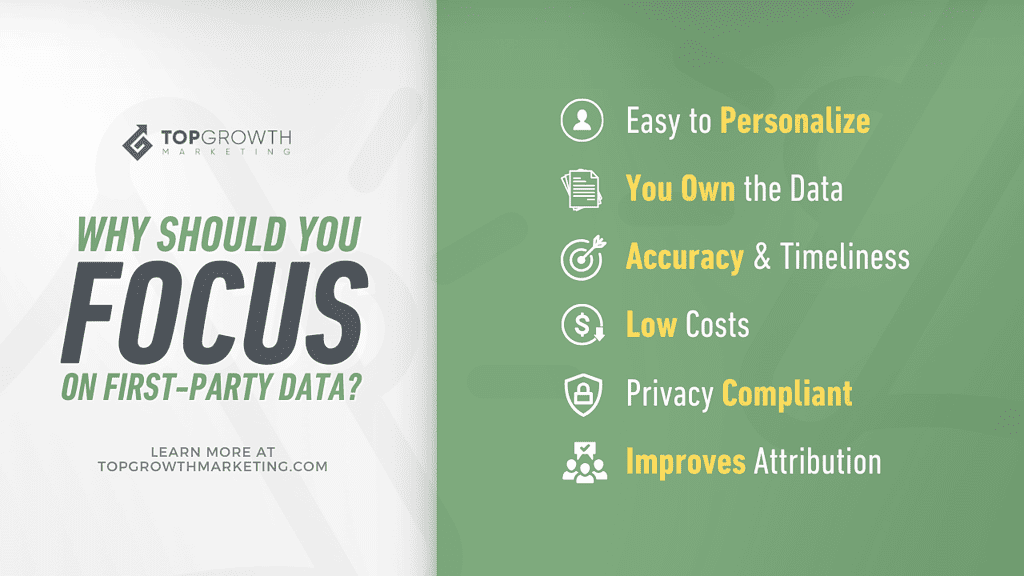
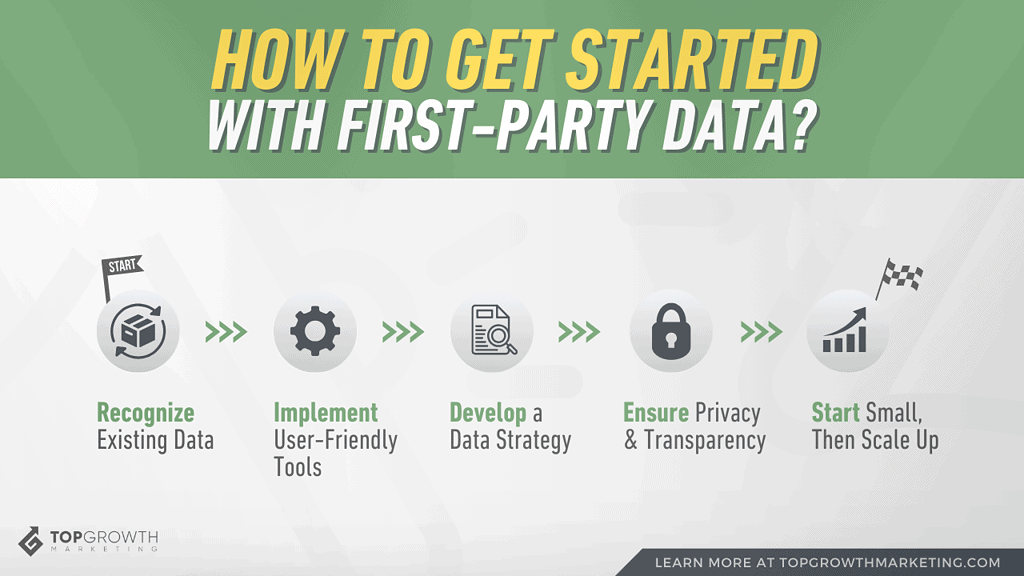

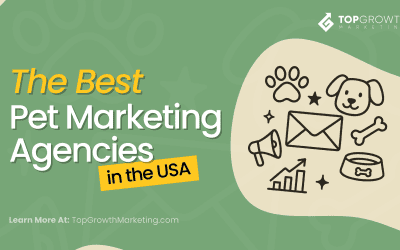
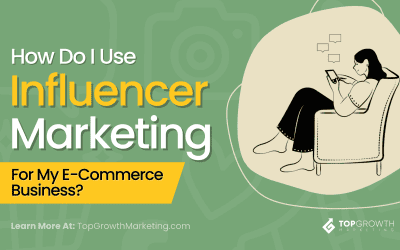

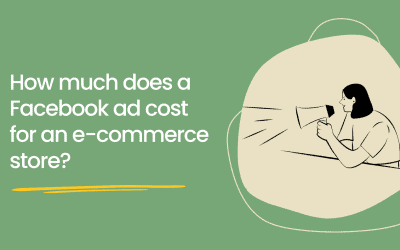
0 Comments